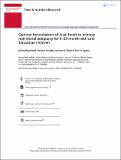| dc.contributor.author | Raymond, Jofrey | |
| dc.contributor.author | Kassim, Neema | |
| dc.contributor.author | Rose, Jerman W. | |
| dc.contributor.author | Agaba, Morris | |
| dc.date.accessioned | 2019-05-20T08:05:30Z | |
| dc.date.available | 2019-05-20T08:05:30Z | |
| dc.date.issued | 2017-07-30 | |
| dc.identifier.issn | 1654-661X | |
| dc.identifier.uri | https://doi.org/10.1080/16546628.2017.1358035 | |
| dc.identifier.uri | http://dspace.nm-aist.ac.tz/handle/123456789/84 | |
| dc.description | Research Article published by Taylor & Francis Group | en_US |
| dc.description.abstract | Background: Achieving nutritional goals of infants and young children while maintaining the
intake of local and culture-specific foods can be a daunting task. Diet optimisation using linear
goal programming (LP) can effectively generate optimal formulations incorporating local and
culturally acceptable foods.
Objective: The primary objective of this study was to determine whether a realistic and affordable
diet that achieves dietary recommended intakes (DRIs) for 22 selected nutrients can be
formulated for rural 6–23-month-old children in Tanzania.
Design: Dietary intakes of 400 children aged 6–23 months were assessed using a weighed dietary
record (WDR), 24-hour dietary recalls and a 7-days food record. A market survey was also carried
out to estimate the cost per 100 g of edible portion of foods that are commonly consumed in the
study area. Dietary and market survey data were then used to define LP model parameters for
diet optimisation. All LP analyses were done using linear program solver (LiPS) version 1.9.4 to
generate optimal food formulations.
Results: Optimal formulations that achieved DRIs for 20 nutrients for children aged 6–11 months
and all selected nutrients for children aged 12–23 months were successfully developed at a
twofold cost of the observed food purchase across age groups. Optimal formulations contained a
mixture of ingredients such as wholegrain cereals, Irish potatoes, pulses and seeds, fish and
poultry meat as well as fruits and vegetables that can be sourced locally.
Conclusions: Our findings revealed that given the available food choices, it is possible to develop
optimal formulations that can improve dietary adequacy for rural 6–23-month-old children if food
budget for the child’s diets is doubled. These findings suggest the need for setting alternative
interventions which can help households increase access to nutrient-dense foods that can fill the
identified nutrient gaps. | en_US |
| dc.language.iso | en_US | en_US |
| dc.publisher | Taylor & Francis Group | en_US |
| dc.subject | Optimal food formulations; | en_US |
| dc.subject | infants and young children | en_US |
| dc.title | Optimal formulations of local foods to achieve nutritional adequacy for 6–23-month-old rural Tanzanian children | en_US |
| dc.type | Article | en_US |

